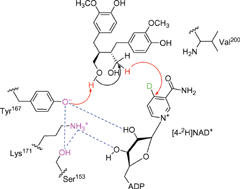Secoisolariciresinol dehydrogenase: mode of catalysis and stereospecificity of hydride transfer in Podophyllum peltatum
Abstract

* Corresponding authors
a
Institute of Biological Chemistry, Washington State University, Pullman, WA, USA
E-mail:
lewisn@wsu.edu
Fax: +1 509 335 8206
Tel: +1 509 335 2682
b NMR Center, School of Molecular Biosciences, Washington State University, Pullman, WA, USA
c School of Molecular Biosciences, Washington State University, Pullman, WA, USA

 Please wait while we load your content...
Something went wrong. Try again?
Please wait while we load your content...
Something went wrong. Try again?
S. G. A. Moinuddin, B. Youn, D. L. Bedgar, M. A. Costa, G. L. Helms, C. Kang, L. B. Davin and N. G. Lewis, Org. Biomol. Chem., 2006, 4, 808 DOI: 10.1039/B516563F
To request permission to reproduce material from this article, please go to the Copyright Clearance Center request page.
If you are an author contributing to an RSC publication, you do not need to request permission provided correct acknowledgement is given.
If you are the author of this article, you do not need to request permission to reproduce figures and diagrams provided correct acknowledgement is given. If you want to reproduce the whole article in a third-party publication (excluding your thesis/dissertation for which permission is not required) please go to the Copyright Clearance Center request page.
Read more about how to correctly acknowledge RSC content.
 Fetching data from CrossRef.
Fetching data from CrossRef.
This may take some time to load.
Loading related content
